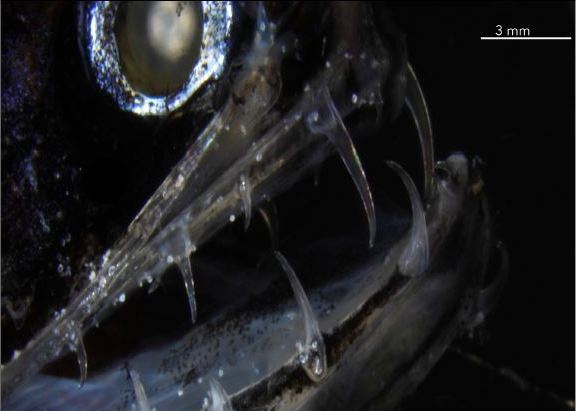Here's Why the Supernaturally Creepy Dragonfish Has Invisible Teeth

You might expect something called a deep-sea dragonfish to be a fearsome leviathan of the deep, dark ocean — and it is, if you happen to be one of the thumb-size ocean critters the dragonfish calls prey.
Dragonfish (genus Aristostomias) are wee (only about 6 inches, or 15 centimeters long), eel-like predators with massive, fang-lined jaws that can yawn open at 120-degree angles. These gaping chompers allow dragonfish to devour prey more than half of their size, but their hunting success also depends on another near-supernatural adaptation: invisibility. While dragonfish bodies give off a faint, bioluminescent glow, their teeth are almost completely transparent, blending into the dark depths around them without tipping off potential prey until the fangs come crunching down.
So, how does this undersea dragon magic work? In a new study published today (June 5) in the journal Matter, scientists took a close look at a dragonfish's transparent teeth under an electron microscope and found out. The answer, the researchers discovered, is an array of grain-size nanocrystals speckled across each fang's enamel, preventing the dragonfish's own bioluminescent light from reflecting off its open jaws.
According to the study authors, this adaptation likely gives dragonfish the edge they need to thrive.
"Most deep-sea fauna have unique adaptations, but the fact that dragonfish have transparent teeth puzzled us, since the trait is usually found in larger species," senior study author Marc Meyers, a materials scientist at the University of California, San Diego, said in a statement. "The dragonfish's teeth are huge in proportion to its mouth — it's like a monster from the movie 'Alien' — and if those teeth should become visible, prey will immediately shy away. We speculate that the teeth are transparent because it helps the predator."
Could the dragonfish's invisible crystal mojo be channeled to create transparent materials that humans could use (like, say, a real-life invisibility cloak)? Possibly. According to the statement, that's what Meyers and his colleagues aim to find out in their next study.
- In Photos: The World's Freakiest-Looking Animals
- In Images: Glowing Creatures of the Deep
- Top 10 Unexplained Phenomena
Originally published on Live Science.
Sign up for the Live Science daily newsletter now
Get the world’s most fascinating discoveries delivered straight to your inbox.

Brandon is the space/physics editor at Live Science. His writing has appeared in The Washington Post, Reader's Digest, CBS.com, the Richard Dawkins Foundation website and other outlets. He holds a bachelor's degree in creative writing from the University of Arizona, with minors in journalism and media arts. He enjoys writing most about space, geoscience and the mysteries of the universe.









